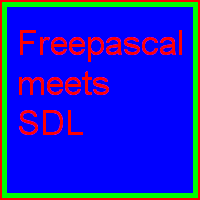Working with the video subsystem assumes that you understand the concept behind. The screen is supposed to be a surface (everything on this surface gets displayed on the physical screen!). Every object you want to display on the screen can be an own surface. Every object can be copied to the screen surface. Surfaces can be manipulated.
For example in the demo03.pp from the SDL4Freepascal files the ball, the paddle and the black background (screen) are surfaces. The ball and the paddle are copied onto the screen surface again and again slightly moved up. So the ball and the paddle are giving the impression that they are moving.
So our task is to create a screen surface. Furthermore we need a surface that contains a picture. Eventually the picture should get copied onto the screen surface. After that the picture should be displayed at the physical screen.
PROGRAM test;
USES crt, SDL, SDL_video;
BEGIN
SDL_INIT(SDL_INIT_VIDEO);
{further code}
SDL_QUIT;
END.
That is where we stopped last chapter. Now we need a command to create a screen surface. Creating a surface is always introduced by setting up a surface variable. The variable type is pSDL_SURFACE and is kind of pointer type as indicated by the “p” in front of it.
The screen surface is a special kind of surface. It has some special properties that can be set. You can set appearance, height, width and colordepth that is displayed by it. The command to make a surface to a screen surface is SDL_SETVIDEOMODE(parameters).
Similar to the SDL_QUIT procedure, after using surfaces you have to clean the memory if you don’t need them anymore. Therefore you use SDL_FREESURFACE(surface).
PROGRAM test; USES crt, SDL, SDL_video; VAR screen:pSDL_SURFACE; BEGIN CLRSCR; SDL_INIT(SDL_INIT_VIDEO); screen:=SDL_SETVIDEOMODE(200,200,8,SDL_SWSURFACE); if screen=nil then HALT; readln; SDL_FREESURFACE(screen); SDL_QUIT; END.
The function to set the screen surface returns nil if an errors occurs. The first parameter determines the width, the second one the height. The third parameter determines the colordepth (8 bit for now) and the last one the appearance (video mode) and space handling. The first three parameters are longint typ, the last one Uint32, where the U stands for “unsigned” (values greater or euqal nil only!), the int stands for “integer” and the number stands for the bit per pixel count. So it is an 32 bit unsigned integer. There are some very interesting values. The chosen one, SDL_SWSURFACE, is used if you want to store the surface in system memory (RAM). Alternatively you could chose SDL_HWSURFACE what causes a storage in video memory. Both will create windowed screens that cannot be resized. SDL_NOFRAME would create a windowed screen without a frame. Eventually there is SDL_FULLSCREEN which leads to a fullscreen display. There are some other possibilities which may be told about in further chapters.
If you run the program you see a black window because nothing is located on the screen surface.
It is necessary to create another surface that contains the picture. Then we need a possibility to load the picture to the surface. Fourtunately there is a command called SDL_LOADBMP(file). The corresponding command is called SDL_SAVEBMP(surface,file) if you drew something onto the screen and would like to save it as a bitmap file. Incidentally there is no such import/export feature for other graphic formats (that doesn’t mean there are no other easy ways to use other important graphic formats ;)).

This picture (8 bit) is the one that will be copied to the screen. The pictures width and height are both exactly 200 pixels.
PROGRAM test;
USES crt, SDL, SDL_video;
VAR
screen,picture:pSDL_SURFACE;
BEGIN
CLRSCR;
SDL_INIT(SDL_INIT_VIDEO);
screen:=SDL_SETVIDEOMODE(200,200,8,SDL_SWSURFACE);
if screen=nil then HALT;
picture:=SDL_LOADBMP('fpsdl.bmp');
if picture=nil then HALT;
readln;
SDL_FREESURFACE(picture);
SDL_FREESURFACE(screen);
SDL_QUIT;
END.
The surface is named “picture” here and the file fpsdl.bmp is located in the same directory as the source file. As already known from setting of the screen variable the SDL_LOADBMP command returns nil if something’s wrong.
In the end we need to copy the loaded picture from the picture surface to the screen surface. This process is called blitting and is made by this command: SDL_BLITSURFACE(parameters).
After the blit process the screen surface has to be refreshed. SDL_UPDATERECT(parameters) is doing that.
PROGRAM test;
USES crt, SDL, SDL_video;
VAR
screen,picture:pSDL_SURFACE;
BEGIN
CLRSCR;
SDL_INIT(SDL_INIT_VIDEO);
screen:=SDL_SETVIDEOMODE(200,200,8,SDL_SWSURFACE);
if screen=nil then HALT;
picture:=SDL_LOADBMP('fpsdl.bmp');
if picture=nil then HALT;
SDL_BLITSURFACE(picture,nil,screen,nil);
SDL_UPDATERECT(screen,15,15,170,170);
readln;
SDL_FREESURFACE(picture);
SDL_FREESURFACE(screen);
SDL_QUIT;
END.
For successful blitting four parameters are requested. The first determines the source surface, the third the destination surface. The second and the fourth parameter can be used if you don’t want to blit the whole surface but a certain rectangle. So you could determine that you want to blit just the upper left quarter of the picture surface (second parameter). Furthermore you could want it copied to the lower right quarter of the screen surface (fourth parameter). If these parameters are nil it means the whole surface is blitted.
As you can see the SDL_UPDATERECT command requests five parameters. The first of them determines which surface has to be refreshed. The next four determine a rectangel with: x-direction, y-direction (from top to bottom), width (relative to x,y-position), height (relative to x,y.position). If all of these paramters are “0” the whole surface will get updated.
This file contains the source code: test.pas (right click and “save as”). The file and the graphic file have to be in the same folder.
Hope you are successful and have fun.